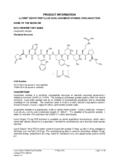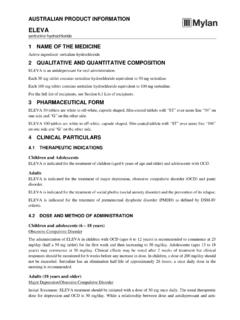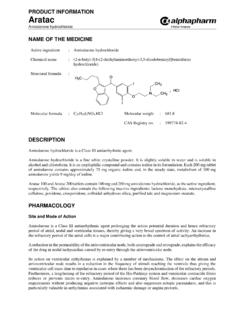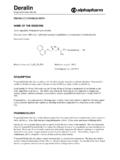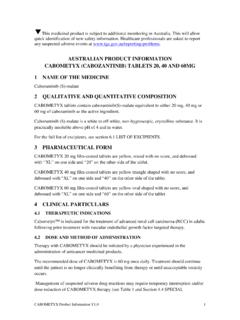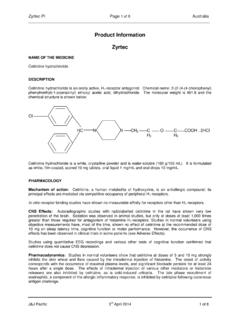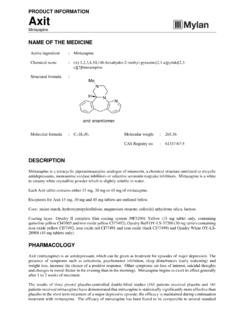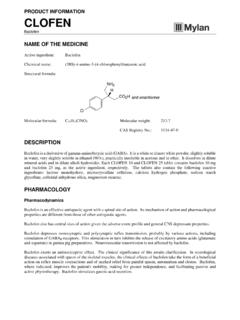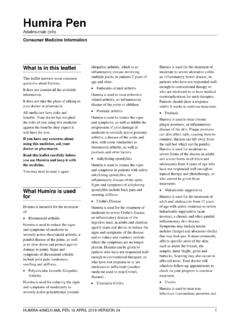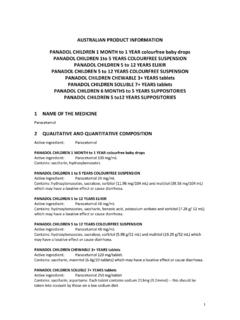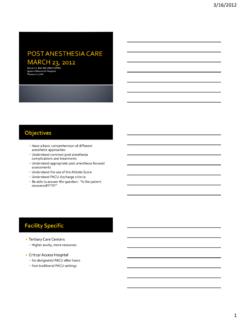Transcription of Minax - Medicines
1 Minax Metoprolol tartrate PRODUCT INFORMATION NAME OF THE MEDICINE Active ingredient : metoprolol tartrate Chemical name : di-[( )-1-(isopropylamino)-3-[p-(2-methoxyethy l) phenoxy]-2-propanol] L(+)-tartrate Structural formula : Molecular formula : (C15H25NO3)2,C4H6O6 Molecular weight : 685 CAS Registry no. : 56392-17-7 DESCRIPTION Metoprolol tartrate, an aryloxypropanolamine derivative, is a white crystalline powder with a melting point of 120 C. The powder is odourless or almost odourless. It is very soluble in water, soluble in chloroform, methylene chloride and alcohol, and almost insoluble in benzene, diethylether and acetone. Each Minax 50 tablet contains 50 mg of metoprolol tartrate. The tablets also contain the following inactive ingredients: lactose, microcrystalline cellulose, povidone, colloidal anhydrous silica, sodium starch glycollate and magnesium stearate. Each Minax 100 tablet contains 100 mg of metoprolol tartrate.
2 The tablets also contain the following inactive ingredients: lactose, microcrystalline cellulose, povidone, purified talc, colloidal anhydrous silica, sodium starch glycollate, carmellose sodium and magnesium stearate. PHARMACOLOGY Pharmacodynamics Metoprolol is a relatively cardioselective -blocker, it acts on 1-receptors mainly located in the heart at lower doses than those needed to influence the 2-receptors mainly located in the bronchi and peripheral vessels. Metoprolol has little membrane-stabilising effect, nor does it display partial agonist activity, intrinsic sympathomimetic activity (ISA), at doses required to produce -blockade. Metoprolol reduces or inhibits the stimulant effect of catecholamines on the heart. This leads to a decrease in heart rate, cardiac contractility and cardiac output. Minax Product Information 2 Metoprolol lowers elevated blood pressure in both the standing and lying position.
3 It also reduces the extent of rises in blood pressure occurring in response to physical and mental stress. In angina pectoris, metoprolol decreases the frequency and severity of the attacks, and the need for glyceryl trinitrate relief, and increases exercise tolerance. Metoprolol has a regulating effect on the heart rate in cases of supraventricular tachycardia or atrial fibrillation, and in the presence of ventricular extrasystoles. Metoprolol lowers mortality in patients with a suspected or confirmed myocardial infarction. This effect may possibly be attributable to a decrease in the incidence of severe ventricular arrhythmias, as well as to limitation of infarct size. Metoprolol has also been shown to reduce the incidence of recurrent myocardial infarction. Due to its -blocking effect, metoprolol is suitable for the prevention of migraine. Metoprolol has been shown to reduce diuretic-induced increase in plasma renin activity.
4 It inhibits catecholamine-induced insulin secretion to a far lesser degree than nonselective -blockers. Orthostatic reactions or disturbances of electrolyte balance have not been observed. In therapeutic doses, metoprolol has less effect on peripheral circulation and the bronchial muscles than nonselective -blockers. However, it should be used with caution in patients with asthma, and concomitant use of an adrenergic bronchodilator, terbutaline or salbutamol, is recommended. Patients already taking 2-stimulants for reversible airways obstruction may require adjustment of dosage of these if metoprolol therapy is subsequently introduced. Metoprolol inhibits catecholamine-induced lipolysis. The active metabolite of metoprolol, 2-hydroxymetoprolol, does not contribute significantly to the therapeutic effect. Metoprolol is a relatively lipid soluble compound less soluble than propranolol and more lipid soluble than atenolol.
5 Pharmacokinetics Absorption and Distribution Metoprolol is rapidly and almost completely (more than 95%) absorbed from the gastrointestinal tract. It is rapidly and extensively distributed to the extravascular tissue. The volume of distribution is L/kg. At therapeutic concentrations approximately 12% of metoprolol is bound to human serum proteins. Metabolism and Excretion Studies with radioactively labelled drug have shown that more than 90% of the dose is excreted in the urine in 72 hours, mainly in the form of known metabolites. Only about 3% of the administered dose is excreted unchanged in the urine in 72 hours. The rate of renal excretion of metoprolol has a linear relationship to its plasma concentration. Metoprolol is excreted mainly by glomerular filtration. Long-term studies have shown that metoprolol neither enhances nor inhibits its own metabolism. The elimination half-life of metoprolol is between 3 and 5 hours.
6 Dose-response The duration of the -blocking effects is dose dependent (as measured by reduction of exercise heart rate). For instance, in healthy subjects the effect of 20 mg metoprolol given intravenously is halved after about 6 hours. Minax Product Information 3 Pharmacokinetics in the elderly Elderly subjects showed no significant differences in the plasma concentrations of metoprolol as compared with young persons, in a study involving eight healthy elderly individuals (mean age years) and eight young subjects (mean age years). INDICATIONS Hypertension: as monotherapy or for use in combination with other antihypertensives. Angina pectoris: for long-term prophylaxis. Glyceryl trinitrate should be employed if necessary for alleviating acute attacks. Confirmed or suspected myocardial infarction Prevention of migraine. CONTRAINDICATIONS Bronchospasm. Beta-adrenergic blockade of the smooth muscle of bronchi and bronchioles may result in an increased airways resistance.
7 These drugs also reduce the effectiveness of asthma treatment. This may be dangerous in susceptible patients. Therefore, -blockers are contraindicated in any patient with a history of airways obstruction or a tendency to bronchospasm. Use of cardioselective -blockers can also result in severe bronchospasm. If such therapy must be used, great caution should be exercised. Alternative therapy should be considered. Hypersensitivity to metoprolol tartrate, related derivatives, or any of the excipients in MINAXs. Sensitivity to other -blockers (cross-sensitivity between -blockers can occur). Second and third degree atrioventricular block. Non-compensated congestive heart failure (see PRECAUTIONS). Sinus bradycardia (less than 45 to 50 beats/minute). Sick-sinus syndrome (unless a permanent, appropriately functioning pacemaker is in place). Severe peripheral arterial circulatory disorders. Shock (including cardiogenic and hypovolaemic shock).
8 Myocardial infarction patients with a heart rate of < 45 beats/minute, a P-R interval of > seconds, a systolic blood pressure of <100 mmHg, and/or moderate to severe non-compensated heart failure. Right ventricular failure secondary to pulmonary hypertension. Significant right ventricular hypertrophy. Hypotension. Untreated phaeochromocytoma (see PRECAUTIONS). Minax Product Information 4 Allergic disorders (including allergic rhinitis) which may suggest a predisposition to bronchospasm. Continuous or intermittent inotropic therapy acting through beta receptor agonism. PRECAUTIONS Bronchospastic disease In general, patients with bronchospastic disease should not be given -blockers of any type ( selective or nonselective). If such therapy must be used, great caution should be exercised. Alternative therapy should be considered. Cardiac failure Beta-blockade depresses myocardial contractility and may precipitate cardiac failure in some patients with a history of cardiac failure, chronic myocardial insufficiency or unsuspected cardiomyopathy.
9 In patients without a history of cardiac failure, continuing depression of the myocardium may lead to cardiac failure. If signs of cardiac failure are present, the patient should be fully digitalised and/or given a diuretic and carefully monitored. If cardiac failure persists, metoprolol tartrate should be discontinued gradually (see PRECAUTIONS - Abrupt withdrawal). Beta-blockers should not be used in patients with untreated congestive heart failure. This condition should first be stabilised. (Note: Although congestive heart failure has been considered to be a contraindication to the use of -blockers, there is a growing literature on the experimental use of -adrenergic blocking drugs in heart failure. As further trials are needed to identify which patients are most likely to respond to which drugs, -blockers should not normally be prescribed for heart failure outside of specialist centres).
10 Prinzmetal angina There is a risk of exacerbating coronary artery spasm if patients with Prinzmetal or variant angina are treated with a -blocker. If this treatment is essential, it should only be undertaken in a Coronary or Intensive Care Unit. Conduction disorders Very rarely, a pre-existing A-V conduction disorder of moderate degree may become aggravated (possibly leading to A-V block). Minax should be administered with caution to patients with first degree A-V block (see CONTRAINDICATIONS). Phaeochromocytoma In patients with phaeochromocytoma, an alpha-blocker ( phentolamine or phenoxybenzamine) should be administered before the -blocker to avoid exacerbation of hypertension. Diabetes Minax should be used with caution in patients with diabetes mellitus, especially those who are receiving insulin or oral hypoglycaemic agents. Diabetic patients should be warned that -blockers affect glucose metabolism and may mask some important premonitory signs of acute hypoglycaemia, such as tachycardia.
